Search results for 'Murachs MySQL My Guitar Shop Database Chapter 17'
-
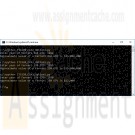
ITS320 Module 3 Option 1 Creating a Program to Calculate the Value of a Ferrari
Regular Price: $10.00
Special Price $8.00
ITS320 Module 3 Option 1 Creating a Program to Calculate the Value of a Ferrari
Option #1: Creating a Program to Calculate the Value of a Ferrari
Assignment Instructions
Implement a program that reads in a year and outputs the approximate value of a Ferrari 250 GTO in that year. Use the following table that describes the estimated value of a GTO at different times since 1962.
Year Value
1962-1964 $18,500
1965-1968 $6,000
1969-1971 $12,000
1972-1975 $48,000
1976-1980 $200,000
1981-1985 $650,000
1986-2012 $35,000,000
2013-2014 $52,000,000
(Source: Programming in Python 3 with Zylabs, Chapter 4, Participation Activity 4.3.5)Assignment Submission Instructions
Learn More
Submit a text file containing your Python code into the Module 3 drop box. Name your file ITS320_CTA3_Option1.py. -
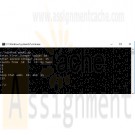
DAT 210 Week 2 Using Loops in Python
Regular Price: $12.00
Special Price $10.00
DAT 210 Week 2 Using Loops in Python
You recently graduated college and you are applying for a programming job that requires the understanding of loops in Python. The manager you are interviewing with has asked you to take an assessment to prove your programming knowledge. Below are the requirements for the programming skills test.
DAT 210 Week 2 Using Loops in Python
You recently graduated college and you are applying for a programming job that requires the understanding of loops in Python. The manager you are interviewing with has asked you to take an assessment to prove your programming knowledge. Below are the requirements for the programming skills test.
In Python, create a program that meets the following requirements:
• Take two integers from the user.
• Save the lower number as x.
• Save the largest integer as y.
• Write a loop that counts from x to y by twos.
• Print out the values of that loop using the Print function in Python.
• Write another loop that adds x and y, and saves the value as Z.
• Print out the values of Z using the Print function in Python.Provide the code and take a screenshot of the output, then paste the screenshot(s) into a Microsoft® Word document.
Review Chapters 6 and 11 of Python for Everyone if you have additional questions on creating a program in Python.
Submit your document.
In Python, create a program that meets the following requirements:
• Take two integers from the user.
• Save the lower number as x.
• Save the largest integer as y.
• Write a loop that counts from x to y by twos.
• Print out the values of that loop using the Print function in Python.
• Write another loop that adds x and y, and saves the value as Z.
• Print out the values of Z using the Print function in Python.
Provide the code and take a screenshot of the output, then paste the screenshot(s) into a Microsoft® Word document.
Review Chapters 6 and 11 of Python for Everyone if you have additional questions on creating a program in Python.
Submit your document.
Learn More -
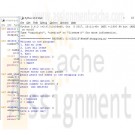
CIS115 Week 6 Lab Shopping List in Python
Regular Price: $12.00
Special Price $10.00
CIS115 Week 6 Lab Shopping List in Python
CIS115 Week 6 Lab Overview
Title of Lab: Shopping List in Python
Summary
Create a program that will allow a user to add, list, and delete items from a shopping list.Deliverables
• A source code Python file.
• A Word document containing both source code and the screen print of the program outputs.Lab Steps
The program should be modular. For example, you will want to have an add_item(shopping_list) function, a delete_item(shopping_list) function, a display_list(shopping_list) function, a display_menu() function, and a main().Sample Output:
Welcome to the program!
1. Add an item
2. List all items
3. Delete an item
4. ExitEnter a menu option: 2
1 : bananas
2 : applesEnter a menu option: 1
Please enter the item: pears
pears was added to the shopping listEnter a menu option: 2
1 : bananas
2 : apples
3 : pearsEnter a menu option: 3
Which number to delete: 3
pears was deletedEnter a menu option: 2
1 : bananas
2 : applesEnter a menu option: 4
have a great day!Specifications:
Learn More
• The program should start with 2 items in the shopping list.
• Don't forget to include at the end of the program the code:
o if __name__ == "__main__":
main();
• Use this code for the delete_item(shopping_list) function:
def delete_item(shopping_list):
number=int(input("Which number to delete: "))
if number<1 or number>len(shopping_list):
print("Invalid number\n")
else:
item=shopping_list.pop(number-1)
print(item," was deleted\n")
print() -
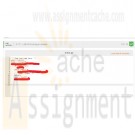
CYB/130 Week 3 Python LAB 4.17: Print string in reverse
Regular Price: $8.00
Special Price $3.00
CYB/130 Week 3 Python LAB 4.17: Print string in reverse
Write a program that takes in a line of text as input, and outputs that line of text in reverse. The program repeats, ending when the user enters "Quit", "quit", or "q" for the line of text.
Ex: If the input is:
Hello there
Hey
quitthen the output is:
Learn More
ereht olleH
yeH -
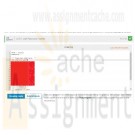
CYB/130 Week 3 Python LAB 4.15: Password modifier
Regular Price: $8.00
Special Price $3.00
CYB/130 Week 3 Python LAB 4.15: Password modifier
Many user-created passwords are simple and easy to guess. Write a program that takes a simple password and makes it stronger by replacing characters using the key below, and by appending "q*s" to the end of the input string.
i becomes !
a becomes @
m becomes M
B becomes 8
o becomes .Ex: If the input is:
mypassword
the output is:
Myp@ssw.rdq*sHint: Python strings are immutable, but support string concatenation. Store and build the stronger password in the given password variable.
Learn More -
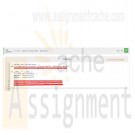
CYB/130 Week 4 Python LAB 5.19: Driving costs - functions
Regular Price: $8.00
Special Price $3.00
CYB/130 Week 4 Python LAB 5.19: Driving costs - functions
Driving is expensive. Write a program with a car's miles/gallon and gas dollars/gallon (both floats) as input, and output the gas cost for 10 miles, 50 miles, and 400 miles.Output each floating-point value with two digits after the decimal point, which can be achieved as follows:
print('{:.2f}'.format(your_value))Ex: If the input is:
20.0
3.1599
the output is:
1.58
7.90
63.20Your program must define and call the following driving_cost() function. Given input parameters driven_miles, miles_per_gallon, and dollars_per_gallon, the function returns the dollar cost to drive those miles.
Ex: If the function is called with:
50 20.0 3.1599
the function returns:
7.89975def driving_cost(driven_miles, miles_per_gallon, dollars_per_gallon)
Learn More
Your program should call the function three times to determine the gas cost for 10 miles, 50 miles, and 400 miles.
Note: This is a lab from a previous chapter that now requires the use of a function. -
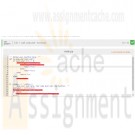
CYB/130 Week 4 Python LAB 5.21: Leap year - functions
Regular Price: $8.00
Special Price $3.00
CYB/130 Week 4 Python LAB 5.21: Leap year - functions
A year in the modern Gregorian Calendar consists of 365 days. In reality, the earth takes longer to rotate around the sun. To account for the difference in time, every 4 years, a leap year takes place. A leap year is when a year has 366 days: An extra day, February 29th. The requirements for a given year to be a leap year are:
1) The year must be divisible by 4
2) If the year is a century year (1700, 1800, etc.), the year must be evenly divisible by 400
Some example leap years are 1600, 1712, and 2016.
Write a program that takes in a year and determines whether that year is a leap year.Ex: If the input is:
1712
the output is:
1712 is a leap year.Ex: If the input is:
1913
the output is:
1913 is not a leap year.Your program must define and call the following function. The function should return true if the input year is a leap year and false otherwise.
def is_leap_year(user_year)Note: This is a lab from a previous chapter that now requires the use of a function.
Learn More -
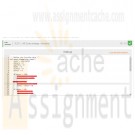
CYB/130 Week 4 Python LAB 5.23: Exact change - functions
Regular Price: $8.00
Special Price $3.00
CYB/130 Week 4 Python LAB 5.23: Exact change - functions
Write a program with total change amount as an integer input that outputs the change using the fewest coins, one coin type per line. The coin types are dollars, quarters, dimes, nickels, and pennies. Use singular and plural coin names as appropriate, like 1 penny vs. 2 pennies.Ex: If the input is:
0
or less, the output is:
no changeEx: If the input is:
45
the output is:
1 quarter
2 dimesYour program must define and call the following function. The function exact_change() should return num_dollars, num_quarters, num_dimes, num_nickels, and num_pennies.
Learn More
def exact_change(user_total)
Note: This is a lab from a previous chapter that now requires the use of a function. -
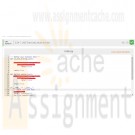
CYB/130 Week 4 Python LAB 5.24: Even/odd values in a list
Regular Price: $8.00
Special Price $3.00
CYB/130 Week 4 Python LAB 5.24: Even/odd values in a list
Write a program that reads a list of integers, and outputs whether the list contains all even numbers, odd numbers, or neither. The input begins with an integer indicating the number of integers that follow.Ex: If the input is:
5
2
4
6
8
10
the output is:
all evenEx: If the input is:
5
1
3
5
7
9
the output is:
all oddEx: If the input is:
5
1
2
3
4
5
the output is:
not even or oddYour program must define and call the following two functions. is_list_even() returns true if all integers in the list are even and false otherwise. is_list_odd() returns true if all integers in the list are odd and false otherwise.
Learn More
def is_list_even(my_list)
def is_list_odd(my_list) -
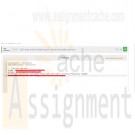
CYB/130 Week 2 Python LAB 3.13: Input and formatted output: House real estate summary
Regular Price: $8.00
Special Price $3.00
CYB/130 Week 2 Python LAB 3.13: Input and formatted output: House real estate summary
Sites like Zillow get input about house prices from a database and provide nice summaries for readers. Write a program with two inputs, current price and last month's price (both integers). Then, output a summary listing the price, the change since last month, and the estimated monthly mortgage computed as (current_price * 0.051) / 12.Output each floating-point value with two digits after the decimal point, which can be achieved as follows:
print('{:.2f}'.format(your_value))Ex: If the input is:
200000
210000
the output is:
This house is $200000. The change is $-10000 since last month.
The estimated monthly mortgage is $850.00.Note: Getting the precise spacing, punctuation, and newlines exactly right is a key point of this assignment. Such precision is an important part of programming.
Learn More




